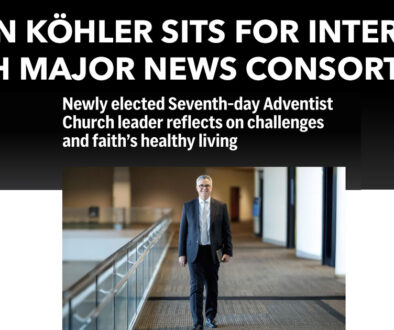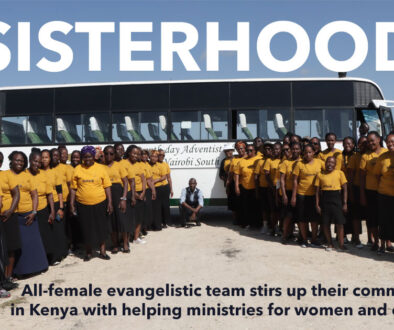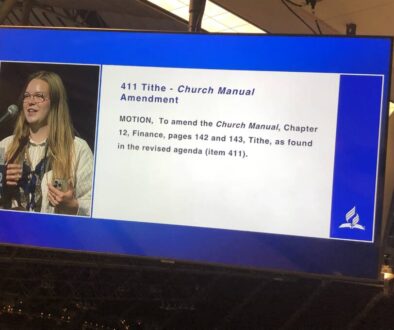Reinder Bruinsma: Adventists and Catholics—What Are the Issues?
25 August 2021 |
The following reading was given us by the author. It is reprinted from Spectrum, 1999, summer, pp. 45-52: “Adventists and Catholics: Prophetic Preview or Prejudice?” You can read the entire essay by clicking here.
Excerpt:
Adventists did not invent anti-Catholicism. Even before the Reformation drastically changed England’s ecclesiastical landscape, there were strong anti-Catholic—or more precisely, antipapal—feelings. The identification of Rome with Antichrist had a long history in many parts of medieval Europe. In Elizabethan times, the view that equated the pope with Antichrist was not just the idea of a fanatical fringe of the Church of England, but had theological respectability. Objections against Catholicism were based on a historicist application of a number of apocalyptic Bible passages and involved political enmity as well as theological disagreement, notably with regard to the sacerdotal priesthood. Among Puritans, the Roman Antichrist became an element of standard exegesis, providing the central organizing principle of their world view.
Sabbatarian Adventism was born in the aftermath of the Great Disappointment of 1844. When the promise of Christ’s return failed to materialize, Millerism fell apart. Remnants of the movement re-grouped and formed a number of denominations. One of the less prominent on the fringe accepted the seventh-day Sabbath and developed into Sabbatarian Adventism, which gradually crystallized its doctrinal position, with the Sabbath and the Sanctuary as key concepts. Sabbatarian Adventism inherited its prophetic framework, however, largely from its Millerite past and received its enduring form in the writings of Uriah Smith, Catholicism and the papacy figured in Sabbatarian Adventism in much the same way as in Millerite writings.
During this phase of Adventism, key concepts were being worked out for use in following decades. These concepts were to determine the eschatological end-time scenario in which both Protestantism and Roman Catholicism would play a prominent role and in which the issue of enforced Sunday worship, combined with persecution of a Sabbath-keeping minority, would figure prominently.
In this context, it is important to note that during this period Adventists leveled criticism for moral and doctrinal corruption more against Protestant churches that had failed to heed the Advent message than against Roman Catholicism. The “fallen” Protestant churches and the “modern” resurgence of Spiritualism clearly eclipsed Catholicism as the main, immediate threat. Yet, knowing what they did about the historic role of the papacy, Adventists found it easy to imagine what might happen in the United States once a sufficiently strong Catholicism joined hands with Protestants in final opposition to God’s loyal Remnant.
In interpretations of the prophecies that Sabbatarian Adventism applied to the Roman Catholic Church the focus shifted to the papacy’s role in the gradual substitution of Sunday for the Sabbath as a day of worship and/or rest. J. N. Andrews pointed to Rome as the place where this substitution was first realized and forcibly promoted. Sabbatarian Adventists saw Protestant Sunday worship as unmistakable proof that Protestants were willing to put a Catholic tradition above clear teachings of the Bible. As the movement elaborated the Sanctuary doctrine, it also criticized Roman Catholicism for its priesthood and alleged animosity toward the Heavenly Sanctuary.
Another significant aspect of this period was the rather limited attention that Sabbatarian Adventists paid to contemporary issues in the Catholic-Protestant debate of the 1850s and 1860s. The Adventist approach to apocalyptic Bible prophecy fostered intense interest in the past rather than the present. In the 1840s to 1860s, Adventist attitudes toward the papacy were not so much shaped by contemporary incidents on the American scene as by historical data that Adventists eagerly collected to undergird their convictions about the role of the papacy in past centuries.
Sabbatarian Adventists of this period were certainly no more anti-Catholic than members of most other Protestant denominations. In fact, they often showed greater restraint in expressing anti-Catholic sentiments—and certainly in taking part in political anti-Catholic activities—than in many sectors of nineteenth-century American Protestantism. A contributing factor to this restraint was undoubtedly the limited numerical strength of Sabbatarian Adventism, which prevented involvement on too many different fronts at the same time. However, emphasis on the imminent Second Coming of Christ and the beginnings of his Kingdom also inevitably discouraged political involvement and helps to explain the Adventists’ refusal to become actively involved in nativist, anti-Catholic political activities. In fact, as Adventists in the 1850s contemplated their obligation toward the world, they tended to see a providential aspect in the large influx of immigrants to the United States: it enabled them to preach their message “to all nations” without needing to go abroad.
Around 1883, Ellen White began to write in a systematic way about the history of the Christian church. Her classic, The Great Controversy, was published in its expanded form in 1888. Another edition appeared with relatively minor changes in 1911. Ellen G. White’s treatment of the history of the Catholic Church did not differ in essence from the approach of other Adventist writers. All the usual elements of Adventist historiography with regard to “The Roman Church” were present: the rise of apostasy in the Early Church; the gradual increase in heretical beliefs and practices; suppression of the Bible; disregard for the second commandment; exchange of Sunday for Saturday observance; the establishment of the papacy; the dark ages of superstition and iniquity; the Inquisiion; papal claims of supremacy over rulers; and the claim of infallibility.
In the chapter entitled “Liberty of Conscience Threatened,” we detect the same insistence as in other representative Adventist publications that Catholicism will never change and that one should be not fooled by “the fair front” it presents to the world. “Every principle of the papacy that existed in ages past exists today,” she wrote (571). The author was careful, however, to distinguish between the Catholic Church as a system and individual believers, many of whom are “real Christians” (565). In contrast, “Romanism as a system is no more in harmony with the gospel of Christ now than at any former period in her history. . . . Let the restraints now imposed by secular governments be removed, and Rome be reinstated in her former power, and there would speedily be a revival of her tyranny and persecution” (564). In the next chapter, “The Impending Conflict,” she extended the scenario further into the future. There, in a few sentences, Ellen G. White summarized what has continued to be the outline of her (and Adventism’s) eschatology:
“The Protestants in the United States will be foremost in stretching their hands across the gulf to grasp the hand of spiritualism; she will reach over the abyss to clasp hands with the Roman power; and under the influence of this threefold union, this country will follow in the steps of Rome in trampling upon the rights of conscience” (588).
Teacher:
Reinder Bruinsma lives in the Netherlands with his wife, Aafje. He has served the Adventist Church in various assignments in publishing, education and church administration on three continents, his last post before retiring as president of the Netherlands Union. He still maintains a busy schedule of preaching, teaching and writing. His latest book is I Have a Future: Christ’s Resurrection and Mine.
Moderator:
Gina Jett is an attorney from Sacramento, California.
How to join:
This program is over. Watch it here!
When:
ATSS starting time depends on where you are. If you’re on the west coast of the United States, it’ll be 10:30 AM. On the east coast, 1:30 PM.
Times around the world:
- Reykjavík: 5:30 PM
- College Place: 10:30 AM
- Lincoln: 12:30 PM
- Denver: 11:30 AM
- Bracknell: 6:30 PM
- Loma Linda: 10:30 AM
- Nairobi: 8:30 PM
- Gackle: 12:30 PM
- Hosur: 11:00 PM
- Waco: 12:30 PM
- Tulsa: 12:30 PM
- Helsinki: 8:30 PM
- Stockholm: 7:30 PM
- Hamburg: 7:30 PM
- Capetown: 7:30 PM
- Madrid: 7:30 PM
- Paris: 7:30 PM
- Honolulu: 7:30 AM
- Cooranbong: 3:30 AM (Sunday)
The class is intended to last about 2 hours, though the conversation often continues to 4 PM.
About our class:
- The AT Sabbath Seminar is intended to be a courteous forum. We discuss and ask questions politely. We don’t accuse, get angry, or put people down.
- Make your comments and questions short—don’t dominate.
- Keep your microphones muted unless you are called upon to make your comment or ask your question.
- Indicate your interest in speaking by raising your electronic hand—under the “reactions” button.
- Those who make accusations or unkind statements will be muted or removed.
- Please use your name when you sign in! Not your phone number, not your initials. This will help us differentiate you from unwelcome guests who want to disrupt us. You can set your name after signing on by clicking on the 3 dots next to your picture, which drops down a menu.
- If it should happen that we are attacked so that we have to stop the meeting, we’ll quickly post a new meeting link on our AT Facebook page.
We look forward to getting acquainted with you!
Coming up:
- Stanley Patterson on organizational evolution
- 11 September – Julius Nam on Critical Race Theory
- Denis Fortin on Ecumenism




